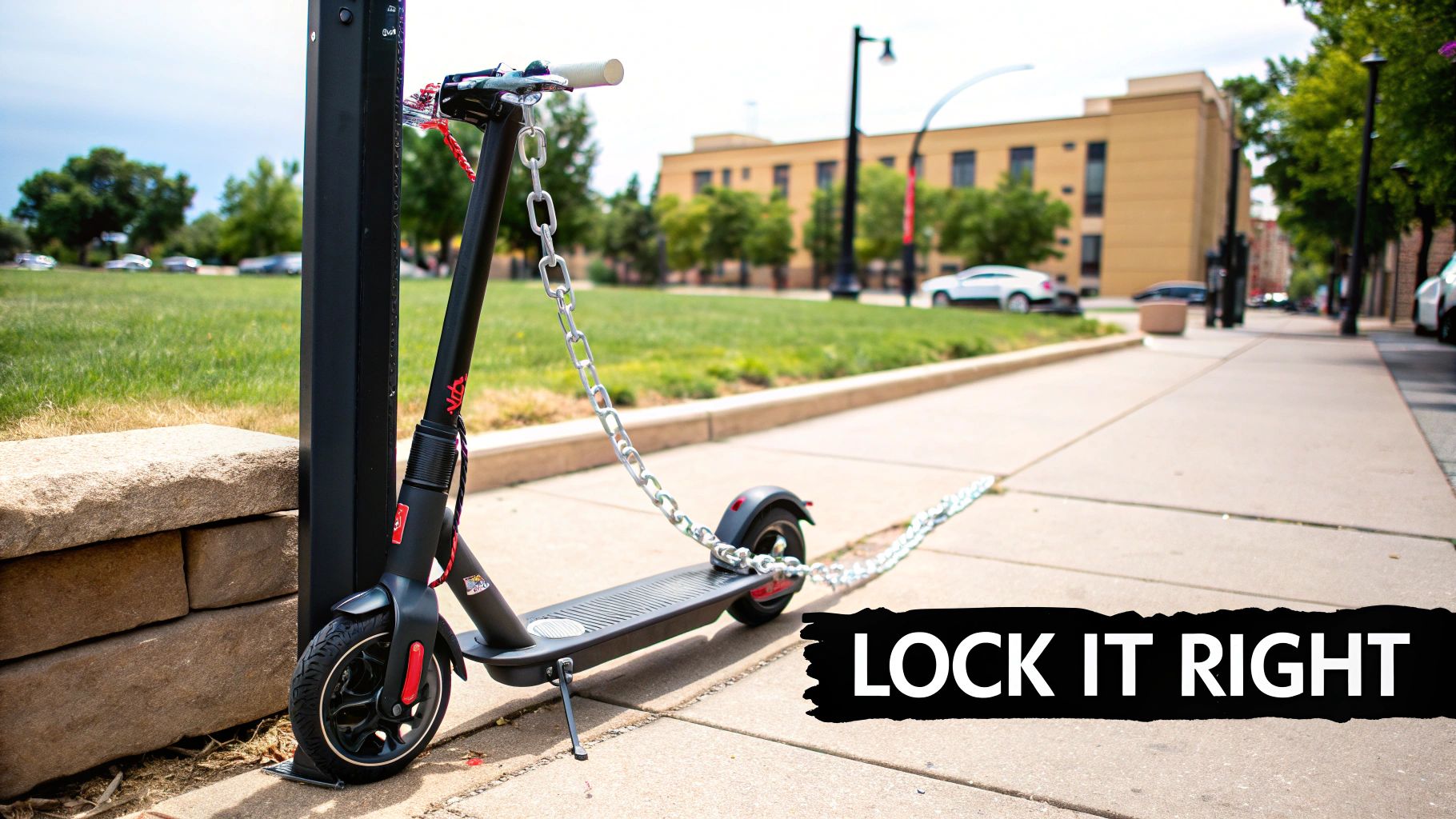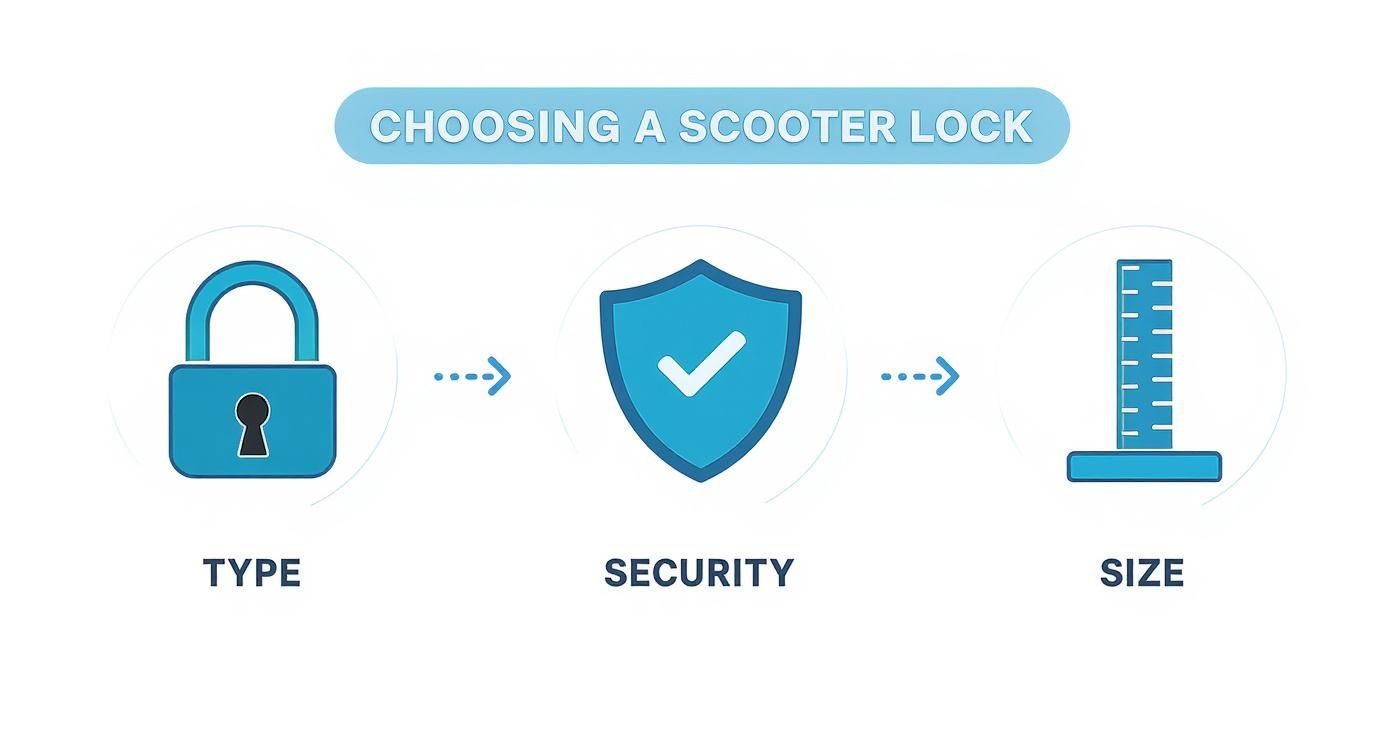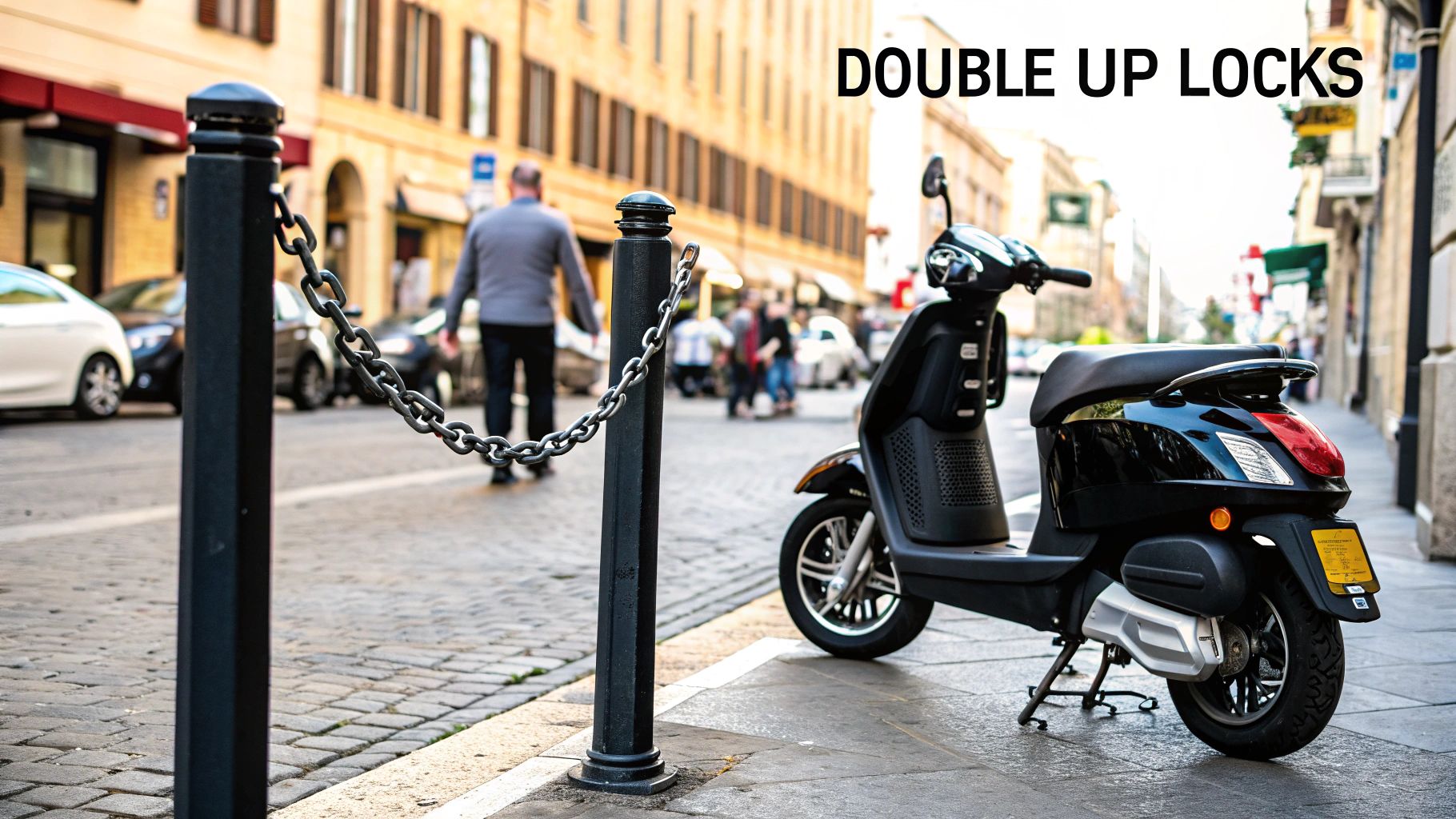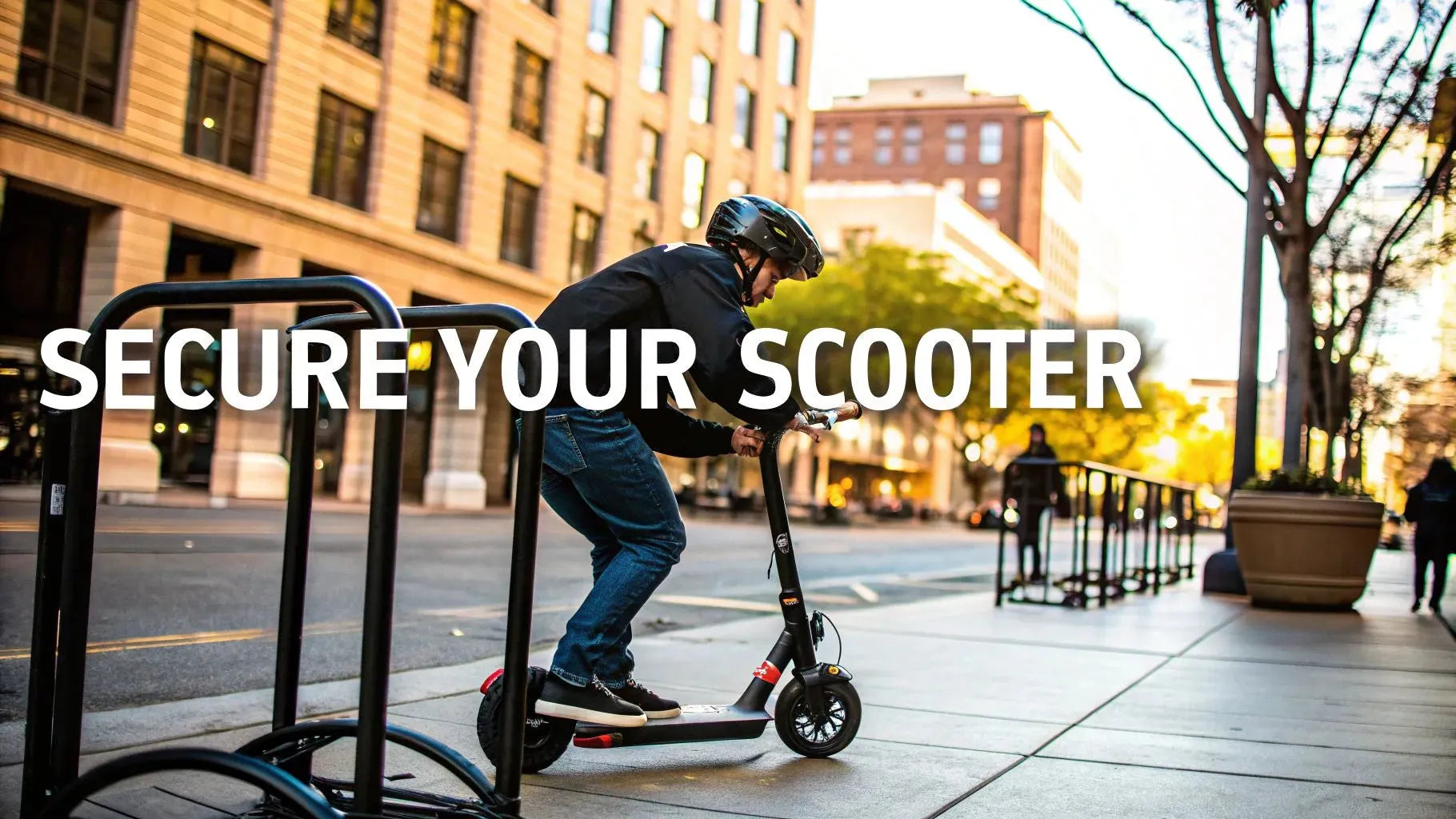Let’s be real for a moment. Locking up your scooter isn't just about slapping any old lock on it and hoping for the best. The secret is to use a high-quality U-lock that goes through both the scooter's frame and the rear wheel, anchoring it to something that’s genuinely stuck to the ground. Doing this one simple thing makes your ride a much less appealing target for thieves.
Your Instant Guide to Locking a Scooter Securely

Alright, let's cut to the chase. You've got a scooter, and you want to keep it. With scooter theft becoming a serious problem across the US and Australia, you need to know how to lock it up right. This isn't just about having a lock; it's about making your scooter the most difficult, annoying, and time-consuming target on the block.
The gold standard is pairing a tough U-lock (sometimes called a D-lock) with a heavy-duty chain. Why both? Because it creates layers of defense. The whole point is to make any potential thief think twice and move on to an easier mark.
The Sobering Reality: Scooter Theft is Skyrocketing
If it feels like you’re hearing more about stolen scooters, you’re not wrong. The numbers are pretty stark. In the US, electric scooter thefts have become so common in some cities that police departments are issuing specific warnings. Meanwhile, in Australia, reports show a significant uptick in e-scooter and e-bike thefts, mirroring trends seen globally.
This isn't just a random spike; it's a trend that shows we need to get serious about security. The days of a flimsy cable lock are long gone. This is also a huge part of our broader advice on essential https://www.punkride.com/blogs/news-advice/electric-scooter-safety-tips, because keeping your ride safe is just as important as riding it safely.
A well-locked scooter sends a clear message to thieves: "Move on, this one is too much trouble." Your goal is to create enough of a deterrent that they look for an easier target elsewhere on the street.
Choosing Your Weapon: A Quick Lock Comparison
Before we get into technique, you need the right tool for the job. Not all locks are created equal, and what works for a quick coffee run might not cut it for overnight parking.
Here’s a quick rundown of the most common lock types to help you figure out what you need.
Scooter Lock Types at a Glance
| Lock Type | Security Level | Portability | Best For |
|---|---|---|---|
| U-Lock / D-Lock | High | Medium | Securing the frame to a solid object in high-risk areas. |
| Heavy-Duty Chain | High | Low | Home security or when leaving the scooter for long periods. |
| Folding Lock | Medium | High | Quick stops and lower-risk areas where portability is key. |
| Cable Lock | Low | High | Securing accessories like helmets, not the scooter itself. |
My go-to recommendation? Combine a U-lock's rigid security with the flexibility of a solid chain. This forces a thief to carry and use two different types of tools, which takes time and makes a lot of noise—two things they absolutely hate.
No matter what you choose, the non-negotiable rule is to always loop your main lock through the scooter's frame (not just a wheel!) and connect it to something that can't be cut, lifted, or unbolted. Think cemented-in bike racks or thick metal railings.
Alright, let's talk about the single most important accessory for your e-scooter: a solid lock.
It’s tempting to grab any old cable lock you see, but trust me, that's like putting a "please steal me" sign on your ride. A cheap lock is a thief's best friend. What you're really investing in here isn't just a heavy piece of metal; it's the freedom to pop into a shop without your stomach dropping.
You’ve basically got three main contenders in the ring: U-locks, beefy chains, and the newer folding locks.
A good U-lock (some people call them D-locks) is the classic choice for a reason. They're rigid, which makes them a nightmare for thieves trying to use leverage to break them open. The only catch is that their rigid shape can be a pain, making it tricky to find a good fit around your scooter and whatever you're locking it to.
Heavy-duty chains give you a lot more flexibility. You can snake them through your scooter's frame and loop them around fat lamp posts or bike racks with ease. The trade-off? They can weigh an absolute ton. Seriously, lugging a massive chain around every day gets old, fast.
What Do Those Security Ratings Actually Mean?
When you’re browsing for locks, you might see ratings like "ART" or brand-specific security scores. These aren't just marketing fluff. They are often from independent rating bodies that show you how much of a beating a lock can take before it gives up. For US and Australian markets, a good rule of thumb is to look for locks made from hardened steel with high ratings from reputable brands.
Here's a general breakdown:
- High-Security (e.g., Kryptonite 8-10/10, Abus 10-15/15): This is the top tier. These locks have been designed to withstand a sustained attack from a pro with a full toolkit, including power tools. If you've spent good money on your e-scooter, this is the only level you should be looking at for high-risk areas.
- Mid-Security: This is a decent middle-ground. It's tested against a determined thief with a smaller set of tools. It might be okay for a quick stop in a low-risk area, but I'd still be nervous.
- Low-Security: This is designed to stop the casual, opportunistic thief. Honestly, for an e-scooter you plan on leaving for more than two minutes, this just isn't going to cut it.
While a universal standard like the UK's Sold Secure website is less common in the US and Australia, checking a brand's own rigorous testing standards and independent reviews is key. A lock that's gone through the wringer in tests designed to copy what thieves actually do is what you want.
Don't Overlook Weight and Size
The toughest lock in the world is completely useless if it’s sitting in your hallway because it’s too heavy to carry. A 30lb chain might be able to stop a tank, but are you really going to haul that thing to work and back every single day? You have to find that sweet spot between a weight you can live with and the security you need.
The best lock is the one you actually use. Don't buy a lock so heavy and cumbersome that you're tempted to leave it behind for "just a quick trip."
Size is just as critical. The golden rule is to get a snug fit. If you use a U-lock and there’s a huge gap inside the shackle, you're giving a thief the perfect space to slide in a car jack or a pry bar and pop it open.
Before you even click "buy," get a tape measure and check the dimensions of the part of your scooter you'll lock up—usually the base of the stem or a solid part of the frame. You want that lock to fit tight, leaving zero room for a thief's tools to get any leverage. For the truly paranoid (like me), using two different types of locks, like a U-lock and a chain, is the ultimate power move.
How to Lock Your Scooter the Right Way
Having a great lock is only half the battle. If your technique is sloppy, even the best lock won't save your ride. Think of it this way: you want to make your scooter look like way too much trouble for any thief who's looking for an easy score.
Let's walk through how to do it right.
Find a Truly Immovable Object
First things first, you need a solid anchor point. I'm talking about something that's genuinely cemented into the ground and isn't going anywhere. A weak anchor makes your expensive lock completely useless.
You’d be surprised what thieves can get through. A flimsy signpost can be bent or even unbolted from the sidewalk. A chain-link fence? A pair of snips will go through that in seconds.
Train your eye to spot the good stuff:
- Thick, dedicated bike racks: These are your best bet. They're built for this exact purpose and are usually in visible, well-lit spots.
- Heavy-duty metal railings: Look for thick, rust-free railings that are concreted straight into the ground. Give it a good, hard shake. If it wiggles, walk away.
- Permanent street furniture: Think massive, heavy city benches or thick bollards that are clearly part of the urban landscape.
This handy infographic lays out the whole thought process, from picking the right lock to making sure it's the right size for the job.

As you can see, it all starts with choosing the right type of lock and checking its security rating before you even think about where to attach it.
Thread the Lock Through the Frame
Okay, you’ve found your rock-solid anchor. Now, how do you actually attach the scooter? This is where so many people get it wrong.
Do not lock through the handlebars, the stem, or just the wheel. These are rookie mistakes. A thief with a wrench can have those parts off in under a minute, leaving you with a single wheel locked to a pole while they walk off with the valuable deck and motor.
Always, always thread your lock through a non-removable part of the scooter's frame. On most models, you'll find a closed loop in the frame itself or a solid section near the folding mechanism where the metal is thickest. This forces a thief to try and cut through your heavy-duty lock or the scooter’s frame—a much louder, more difficult, and riskier job.
Key takeaway: A tight lock is a safe lock. Any extra space or slack you leave in your U-lock or chain is a weak point. It gives a thief room to slide in a crowbar or a bottle jack and use leverage to pop it open.
Avoid These Common (and Costly) Mistakes
Learning what not to do is just as important. Thieves love it when riders make these simple errors.
Here are the big ones I see all the time:
- Leaving too much slack: As I mentioned, a loose chain or a U-lock with tons of empty space is a gift to a thief. Cinch it up as tight as you can against both the scooter and the anchor.
- Only locking the wheel: I can't stress this enough. A wheel is easy to remove. Your main lock must secure the frame. If you want to secure the wheel, use a secondary cable lock for it.
- Letting the lock touch the ground: This is a big one. When your lock is on the pavement, a thief can use the ground for leverage to smash it with a hammer or get a better angle with bolt cutters. Always keep it suspended in the air.
By sidestepping these common pitfalls, your scooter instantly becomes a less attractive target. You're making a potential thief's job harder, noisier, and longer—three things they absolutely hate.
Layering Your Security Beyond Just a Lock
https://www.youtube.com/embed/CDczPoC7kbs
A great lock is your first line of defense, absolutely. But experienced riders know that relying on just one thing is a recipe for disaster. If you really want to protect your scooter, you need to think in layers. Your goal is to make your scooter a loud, trackable, and deeply annoying target for any would-be thief.
This is where a little bit of smart tech goes a long way. Security isn't just about stopping a grinder with brute force anymore; it's about outsmarting the person holding it. Adding a couple of electronic deterrents can be the difference between finding your scooter right where you left it and staring at an empty space on the sidewalk.
Add an Electronic Watchdog with an Alarm
One of the best and cheapest upgrades you can make is a motion-activated alarm. These are small, easy-to-hide devices you can stick under the deck or tuck away near the handlebars. You arm it, and it waits. The second it senses someone messing with your scooter—jiggling the lock, trying to lift it—it goes off.
And when I say it goes off, I mean it screams. Many of these alarms blast out a sound well over 110 decibels, which is painfully loud. It’s the kind of noise that makes everyone on the street turn their head, and that’s the last thing a thief wants. Often, that sudden, piercing shriek is enough to make them drop everything and run.
The whole point of an alarm is to create a scene. Thieves thrive on being invisible, and a powerful alarm yanks that advantage away and puts a giant spotlight right on them.
The goal is to make stealing your scooter as difficult, noisy, and risky as humanly possible. A tough lock paired with a shrieking alarm forces a thief to solve two very different problems at the same time, usually under a lot of unwanted attention.
Get it Back with a GPS Tracker
An alarm is fantastic for stopping a theft in its tracks, but what if the thief actually gets away with it? That's where a GPS tracker becomes your secret weapon. These are tiny devices you can hide deep inside your scooter's frame, giving you a live feed of its location right on your phone.
We're seeing GPS tracking become a standard part of scooter security for a reason. Many newer e-scooters come with it built-in, and they can nail down a location to within a few feet. The demand is huge—the scooter anti-theft market in the Asia Pacific region alone hit $670 million in one year. That tells you how many people are relying on this tech. You can read more about these proven e-bike and scooter theft prevention methods on ridewattly.com.
You’ve got a couple of choices when it comes to trackers:
- Wired Trackers: These hook right into your scooter's battery. The huge plus here is that you never have to think about charging them. They're always on.
- Standalone Units: Think Apple AirTags or other battery-powered GPS units. They offer more flexibility in terms of where you can hide them since they don't need to be wired in.
Having a tracker completely changes the game. It transforms a total loss into a recovery mission, giving you and the police a real shot at getting your scooter back. This layered approach is also critical for keeping your ride safe when it's put away for a while, which we cover in our guide to effective electric bike and scooter storage solutions.
When you combine a strong lock, a loud alarm, and a hidden tracker, you’ve built a security system that will make almost any thief decide to look for an easier target.
Smarter Locking in High-Risk Areas

Locking your scooter outside a sleepy suburban café is one thing. But leaving it chained up on a sprawling university campus or in the middle of Sydney or New York? That's a completely different game. High-risk areas are practically a playground for professional thieves who know exactly what they're looking for and have the tools to take it. To beat them, you have to start thinking like them.
Your entire mindset needs to shift. You're not just "locking up your scooter." You're making it the single most annoying, difficult, and time-consuming target on the entire street. Thieves are all about efficiency—they want the quickest, quietest score they can find. Your job is to make your scooter the opposite of that.
The University Campus Hotspot
University campuses, particularly in the US and Australia, have become a thief's paradise. You've got a high concentration of valuable scooters and students with predictable class schedules, creating the perfect hunting ground. The problem got so bad at Florida International University that they saw a staggering 252% spike in scooter thefts in a single year. And they're not alone; it's a huge issue on campuses everywhere.
This isn’t just an American problem. Big cities across Australia are facing the exact same thing. The crucial thing to understand here is that you're not just trying to stop some kid from getting a joyride. You're up against pros who often work in pairs and can get through an average lock in less than 60 seconds.
In a high-risk area, your lock isn’t just a deterrent—it’s a direct challenge. You want a thief to take one look at your setup, sigh, and move on to an easier target.
Double Down Your Defence
This is where using two locks becomes absolutely essential. It’s not about paranoia; it’s about strategy. Using two different types of high-quality locks is the best thing you can do because it forces a thief to carry and use two completely different sets of tools.
Here’s a combo I’ve seen work time and again:
- A high-security U-lock: This should be your primary lock. Use it to secure the frame of your scooter to whatever you're locking it to. Its solid, rigid design is a nightmare for anyone trying to use leverage attacks.
- A heavy-duty chain lock: Weave this beast through your rear wheel and frame, then secure it back to the U-lock or the anchor point. A thick chain is much tougher to attack with a pry bar and often requires a different tool altogether.
This two-lock system directly attacks a thief's most valuable asset: speed. Cutting a U-lock might need an angle grinder, but snapping a heavy chain often requires massive bolt cutters. Forcing them to carry both tools, and making them waste time switching between them, dramatically increases their risk of getting caught. It turns a quick job into a slow, noisy, frustrating one.
And while you're thinking about security, don't forget the local rules. Our guide on electric scooter laws by state can help you stay on the right side of any regulations that might affect where you can park in the US.
Situational Awareness is Everything
At the end of the day, your best security tool is your brain. Before you even pull out your locks, take a second to think like a thief. Where would you not want to be caught trying to steal something?
Always go for spots with tons of foot traffic and bright lighting, preferably right under a CCTV camera. Stay away from deserted alleys or hidden corners, no matter how convenient they seem. A thief absolutely hates having an audience.
And here’s the golden rule for high-risk spots: Never, ever leave it overnight. The cover of darkness gives a thief all the time in the world to work on your locks without being disturbed. If you absolutely have to leave it for a long time, make sure it’s in the most visible, well-lit spot you can possibly find.
Got Questions About Scooter Security? We've Got Answers.
Still got a few things bouncing around in your head? Good. Nailing the small details is what will keep your scooter right where you left it. Here are some no-nonsense answers to the questions I hear most often from riders.
Can I Just Lock It Up by the Handlebars?
Please don't. That's probably the most common mistake I see new riders make. Think about it: a thief with a couple of basic tools can have those handlebars off in under a minute. They'll just slide the rest of your expensive scooter right out of the lock and be on their way, leaving you with a sad, lonely handlebar.
You've got to lock the main frame—the part that doesn't come off. Look for a solid, closed loop of metal on the frame itself. Locking through the base of the folding mechanism is also a solid choice because it’s one of the strongest points on the whole scooter and can't just be unbolted.
Is One Really Good Lock Enough?
Look, one top-tier, high-security rated lock is a fantastic start and will stop most opportunistic thieves. But if you’re parking in a major city or on a college campus, two locks is the real pro move. The secret sauce is using two different kinds of locks, like a beefy U-lock paired with a heavy-duty chain.
Why? It forces a thief to carry two different sets of tools to break them. That's a huge hassle. It means more time, more noise, and way more risk for them. Most will take one look and decide to go find an easier target.
A single lock is a hurdle; two different locks is a fortress. It tells a would-be thief that you're not playing around and that your scooter is more trouble than it's worth.
What Do I Do If My Locked Scooter Is Stolen Anyway?
The absolute key here is to act fast. Those first few hours are everything when it comes to getting it back.
- Call the police, stat: Don't wait. Report it immediately. Have your scooter's serial number, make, model, and any photos ready to give them.
- Fire up the tracker: If you have a GPS tracker, this is its moment to shine. Share the live location data with the police. This is your single best chance for recovery.
- Phone your insurance: If your scooter is insured against theft, get on the phone with your provider and get that claim started.
- Become a digital detective: Scour local online listings like Facebook Marketplace, Gumtree, and Craigslist. Stolen scooters often get posted for a quick sale within 24-48 hours. The faster you spot it, the better.
Ready to gear up and protect your ride? At Punk Ride LLC, we’ve got a massive selection of high-performance electric scooters and all the security essentials you need to keep them safe. Check out our collection and ride with total peace of mind.





Share:
Understanding Electric Bike Weight Limits
How to Fold Scooter: The Easy Way